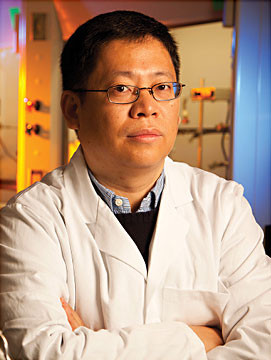Younan Xia, Ph.D.
Nanomedicine
Georgia Institute of Technology
Recruited: 2012
Younan Xia is one of the world’s foremost materials scientists, a renowned chemist in nanomaterial synthesis. He was ranked fourth in the field of materials science by Thomas Reuters Science Watch and fifth in the field of chemistry by Times Higher Education for the number of articles he has published, and the number of times those publications are cited by other researchers.
At Georgia Tech, Xia studies how atoms collect into small clusters that eventually form nanocrystals. He has learned to manipulate this process to build nanocrystals with specific electronic, magnetic, catalytic and optical properties. Properly designed, these nanocrystals can be used to visualize disease, deliver drug therapies and heal injured tissues.
Xia has created nanofibers that rejoin tendon to bone and invented copper wires with a diameter of just 24 nanometers – by contrast, a human hair is 60,000 nanometers. He also has engineered materials at the smallest imaginable scale — for example, building a network of platinum atoms that can be used to produce a more affordable fuel cell.
Much of Xia’s work involves gold nanocages – tiny, hollow particles that can also carry payloads. Xia invented the nanocages while at the Washington University in St. Louis; he is now experimenting with how they can be used to find cancer in its early stages, attach to cancerous cells and potentially deliver drugs to the site of an infection.
Research
Xia’s lab is focused on materials and structures smaller than 100 nanometers. Studies include:
- Synthesis. Xia uses chemical synthesis, theoretical modeling, mass spectrometry and electron microscope analysis to understand and control the growth steps in synthesizing nanomaterials, from atoms to clusters to nanostructures. This work aims to build a scientific base for large-scale production of nanomaterials with the specific properties needed for use in electronics, photonics, catalysis, information storage, optical sensing and biomedical research.
- Biomedical research applications. Xia is seeking new ways to use functional nanomaterials. Current efforts include:
- Developing gold nanocages as contrast agents for optical imaging (e.g., optical coherence tomography, photoacoustic tomography, and multi-photon luminescence), and as photothermal agents for therapeutic treatment.
- Exploring how to use gold nanocages and other metal nanostructures as substrates for SERS- and LSPR-based detection.
- Building nanoscale capsules by integrating gold nanocages with smart polymers and/or phase-change materials for targeted delivery and controlled release with superb spatial/temporal resolutions.
- Applying electrospun nanofibers to regenerative medicine, neural tissue engineering, drug release and tendon-to-bone insertion site repair.
- Designing new colloidal particles with superparamagnetic features for separation, detection, manipulation and tracking of biological species and cellular events.
- Environmental research. Xia fabricates novel materials that can improve the performance of solar cells, fuel cells, catalytic converters and water-splitting devices.
Choosing Georgia
Xia came to Georgia enthusiastic about establishing a program on nanomedicine, which will make it possible to translate his fundamental research on nanomaterial synthesis into something useful to society. He was impressed by Georgia Tech’s strategic vision, research infrastructure, superb students, and collegial atmosphere.
Intellectual Property
6

